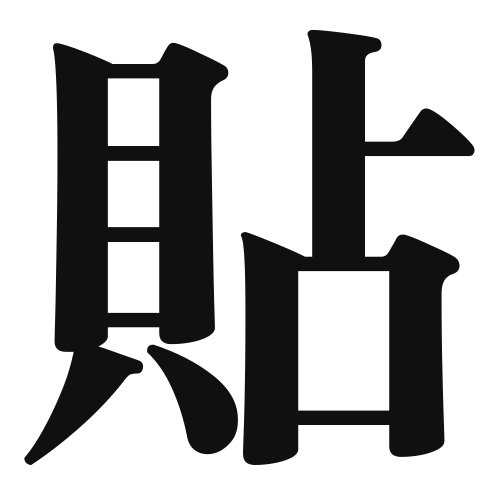1. Overview of Meaning
The kanji “貼” (pronounced “haru” or “chou”) means “to stick,” “to paste,” or “to affix.” It is commonly used in contexts where something is attached or adhered to another surface.
2. Formation and Radical
Formation of the Kanji: The kanji “貼” is a compound character (会意文字) that combines elements to convey its meaning. It consists of the radical for “cloth” (巾) and the character “to attach” (接), symbolizing the action of sticking or pasting something onto a surface.
Radical: The radical of “貼” is 巾 (kin), which relates to cloth or fabric, emphasizing the idea of sticking or attaching materials together.
3. Examples of Usage
Common Words and Phrases: Some frequently used words that include “貼” are:
- 貼紙 (はりがみ, harigami) – sticker
- 貼付 (ちょうふ, choufu) – attachment, affixing
Example Sentences in Daily Conversation:
- この貼紙は、壁に貼ってください。 (このはりがみは、かべにはってください。) – Please stick this sticker on the wall.
- 書類に必要な情報を貼付してください。 (しょるいにひつようなじょうほうをちょうふしてください。) – Please attach the necessary information to the document.
4. Synonyms and Antonyms
Similar Kanji: A similar kanji is “接” (せつ, setsu), which means “to connect” or “to join.” While both kanji involve the idea of attachment, “接” emphasizes the act of connecting rather than sticking.
Antonyms: An antonym of “貼” is “剥がす” (はがす, hagasu), which means “to peel off” or “to remove,” indicating the opposite action of detaching something that has been stuck.
5. Cultural and Historical Background
Relation to Japanese Culture: The concept of sticking or pasting is significant in various aspects of Japanese culture, such as in traditional crafts like origami and calligraphy, where precision in attachment is valued.
Proverbs and Idioms: One relevant idiom is “貼り付ける” (はりつける, haritsukeru), which means “to stick on” and is often used in contexts involving technology, such as attaching files or images in digital communication.
